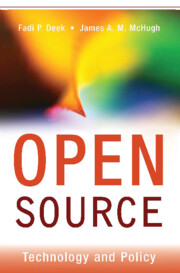Book contents
- Frontmatter
- Contents
- Preface
- Acknowledgments
- 1 Introduction
- Section One Open Source – Internet Applications, Platforms, and Technologies
- Section Two Social, Psychological, Legal, and Economic Aspects of Open Source
- Section Three Free Software: The Movement, The Public Sector, and the Future
- Glossary
- Subject Index
- Author Index
- References
1 - Introduction
Published online by Cambridge University Press: 16 January 2010
- Frontmatter
- Contents
- Preface
- Acknowledgments
- 1 Introduction
- Section One Open Source – Internet Applications, Platforms, and Technologies
- Section Two Social, Psychological, Legal, and Economic Aspects of Open Source
- Section Three Free Software: The Movement, The Public Sector, and the Future
- Glossary
- Subject Index
- Author Index
- References
Summary
The open source movement is a worldwide attempt to promote an open style of software development more aligned with the accepted intellectual style of science than the proprietary modes of invention that have been characteristic of modern business. The idea – or vision – is to keep the scientific advances created by software development openly available for everyone to understand and improve upon. Perhaps even more so than in the conventional scientific paradigm, the very process of creation in open source is highly transparent throughout. Its products and processes can be continuously, almost instantaneously scrutinized over the Internet, even retrospectively. Its peer review process is even more open than that of traditional science. But most of all: its discoveries are not kept secret and it lets anyone, anywhere, anytime free to build on its discoveries and creations.
Open source is transparent. The source code itself is viewable and available to study and comprehend. The code can be changed and then redistributed to share the changes and improvements. It can be executed for any purpose without discrimination. Its process of development is largely open, with the evolution of free and open systems typically preserved in repositories accessible via the Internet, including archives of debates on the design and implementation of the systems and the opinions of observers about proposed changes. Open source differs vastly from proprietary code where all these transparencies are generally lacking. Proprietary code is developed largely in private, albeit its requirements are developed with its prospective constituencies.
- Type
- Chapter
- Information
- Open SourceTechnology and Policy, pp. 1 - 18Publisher: Cambridge University PressPrint publication year: 2007



